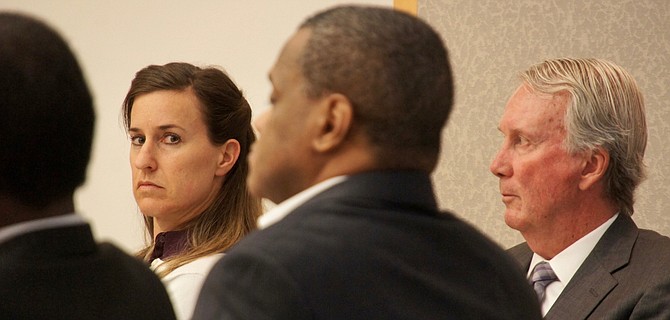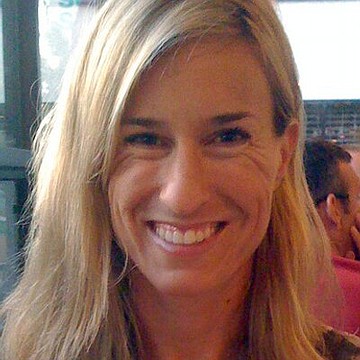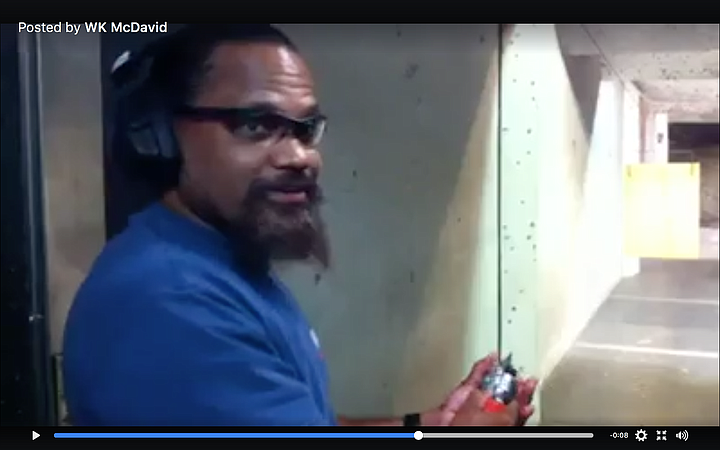 Facebook
Facebook
 X
X
 Instagram
Instagram
 TikTok
TikTok
 Youtube
Youtube

A two-defendant trial in which a Carlsbad woman is accused of hiring her gun instructor to shoot her husband after a years-long divorce battle was given to the jury to deliberate on November 9th.

The jury of eight women and four men heard evidence against Diana Jean Lovejoy, 45, and Weldon Kermit McDavid Jr., 50, for two weeks. The defendants pleaded not guilty to conspiracy and attempted murder.
Former Marine shooting instructor McDavid took the witness box to convince the jury that he was too skilled a marksman to miss a shot to the body, “center mass,” but instead he missed a shot attempting to extinguish the bright light that 47-year-old Greg Daniel Mulvihill was holding in his left hand.
The prosecutor alleges that McDavid phoned Mulvihill late the night of September 1, 2016, to lure him to a dark and secluded location to kill him. McDavid admitted phoning the estranged husband about 10:30 p.m. that night and luring him to a dirt path near Mulvihill’s apartment in San Marcos, but McDavid claimed he only wanted to get video of Mulvihill collecting incriminating evidence against him.

After Mulvihill got the strange phone call that night, offering him a chance to see unexplained evidence against him, he picked up a friend who lived in the same apartment complex to come with him. Prosecutor Jodi Breton asserted that this second person coming to the location was a problem for the shooter, especially since that person was walking back and forth, separately from Mulvihill.
McDavid admitted shooting his custom AR-15 with pistol grip, outfitted with an illegal silencer. The first bullet entered Mulvihill’s torso under his armpit and exited out his shoulder; he survived after emergency surgery.
Mulvihill testified and showed the jury his scars. There was much discussion about where Mulvihill was holding the light he used that night — out to one side and above his head or in front of his torso. The defense claims that when McDavid missed his shot trying to destroy the light, the bullet traveled into Mulvihill’s body.
An expert shooting instructor from Carlsbad police testified that he believed McDavid was shooting at the last known place he had seen his “center mass” target — that would be Mulvihill’s torso — but his target had become alarmed and turned to flee, which caused the bullet to enter under his arm. “It happens to police all the time,” said Carlsbad police sergeant Greg White. “I think his bullet hit exactly where he had it aimed. I believe he was aiming center mass.”

After McDavid fired one shot that passed through Mulvihill, he fired six more shots as both men ran for their lives, back down the dark dirt path toward Avenida Soledad.
Prosecutor Breton created a video that recreated the shooting scene, at the same time of night at the same location, using the same bike light that Mulvihill had carried. She intended to show the jury how blinding the handheld light was, from the point of view of the shooter, and then what could be seen when the two men turned and ran for their lives. All attorneys agreed that video was sufficient, and previous plans for a “scene view,” in which jurors would have been bused to the location at night, were abandoned.
McDavid admitted having a sexual relationship with his gun-instruction client, Diana Lovejoy, and that she paid him $1000 upfront of a $2000 fee, he said to get evidence against her husband. The prosecutor alleges that McDavid was financially struggling after he was kicked out of the Marines and then lost his job at Iron Sights, a popular indoor shooting range in Oceanside.
McDavid’s wife testified during trial and sat in the courtroom to hear closing arguments of attorneys.
Lovejoy did not testify. When she was arrested a week after the shooting, police claim she was wearing some of the same clothing seen in store surveillance video when she bought the disposable TracFone the shooter used to call her husband that night.
McDavid admitted in the witness box that he called Lovejoy to come pick him up at a Park & Ride near the shooting site; she then dropped him off at Avenida Soledad, and he directed her to go home and wait for him to call her after the deed was done. McDavid’s and Lovejoy’s attorneys deny there was any agreement to kill Lovejoy’s then-husband.
The divorce battle began in July 2014. By June 2016, the court judgments were going against Lovejoy: her husband had won equal custody of their three-year-old son, she was ordered to pay monthly child support to her husband, and soon Lovejoy would have to pay a $120,000 settlement to Mulvihill from the sale of a condo she owned.
Jurors are expected to continue deliberations on Monday, November 13, in San Diego’s North County Superior Courthouse in Vista.
The defendants continue to be held in custody, in lieu of $2 million bail, each.


A two-defendant trial in which a Carlsbad woman is accused of hiring her gun instructor to shoot her husband after a years-long divorce battle was given to the jury to deliberate on November 9th.

The jury of eight women and four men heard evidence against Diana Jean Lovejoy, 45, and Weldon Kermit McDavid Jr., 50, for two weeks. The defendants pleaded not guilty to conspiracy and attempted murder.
Former Marine shooting instructor McDavid took the witness box to convince the jury that he was too skilled a marksman to miss a shot to the body, “center mass,” but instead he missed a shot attempting to extinguish the bright light that 47-year-old Greg Daniel Mulvihill was holding in his left hand.
The prosecutor alleges that McDavid phoned Mulvihill late the night of September 1, 2016, to lure him to a dark and secluded location to kill him. McDavid admitted phoning the estranged husband about 10:30 p.m. that night and luring him to a dirt path near Mulvihill’s apartment in San Marcos, but McDavid claimed he only wanted to get video of Mulvihill collecting incriminating evidence against him.

After Mulvihill got the strange phone call that night, offering him a chance to see unexplained evidence against him, he picked up a friend who lived in the same apartment complex to come with him. Prosecutor Jodi Breton asserted that this second person coming to the location was a problem for the shooter, especially since that person was walking back and forth, separately from Mulvihill.
McDavid admitted shooting his custom AR-15 with pistol grip, outfitted with an illegal silencer. The first bullet entered Mulvihill’s torso under his armpit and exited out his shoulder; he survived after emergency surgery.
Mulvihill testified and showed the jury his scars. There was much discussion about where Mulvihill was holding the light he used that night — out to one side and above his head or in front of his torso. The defense claims that when McDavid missed his shot trying to destroy the light, the bullet traveled into Mulvihill’s body.
An expert shooting instructor from Carlsbad police testified that he believed McDavid was shooting at the last known place he had seen his “center mass” target — that would be Mulvihill’s torso — but his target had become alarmed and turned to flee, which caused the bullet to enter under his arm. “It happens to police all the time,” said Carlsbad police sergeant Greg White. “I think his bullet hit exactly where he had it aimed. I believe he was aiming center mass.”

After McDavid fired one shot that passed through Mulvihill, he fired six more shots as both men ran for their lives, back down the dark dirt path toward Avenida Soledad.
Prosecutor Breton created a video that recreated the shooting scene, at the same time of night at the same location, using the same bike light that Mulvihill had carried. She intended to show the jury how blinding the handheld light was, from the point of view of the shooter, and then what could be seen when the two men turned and ran for their lives. All attorneys agreed that video was sufficient, and previous plans for a “scene view,” in which jurors would have been bused to the location at night, were abandoned.
McDavid admitted having a sexual relationship with his gun-instruction client, Diana Lovejoy, and that she paid him $1000 upfront of a $2000 fee, he said to get evidence against her husband. The prosecutor alleges that McDavid was financially struggling after he was kicked out of the Marines and then lost his job at Iron Sights, a popular indoor shooting range in Oceanside.
McDavid’s wife testified during trial and sat in the courtroom to hear closing arguments of attorneys.
Lovejoy did not testify. When she was arrested a week after the shooting, police claim she was wearing some of the same clothing seen in store surveillance video when she bought the disposable TracFone the shooter used to call her husband that night.
McDavid admitted in the witness box that he called Lovejoy to come pick him up at a Park & Ride near the shooting site; she then dropped him off at Avenida Soledad, and he directed her to go home and wait for him to call her after the deed was done. McDavid’s and Lovejoy’s attorneys deny there was any agreement to kill Lovejoy’s then-husband.
The divorce battle began in July 2014. By June 2016, the court judgments were going against Lovejoy: her husband had won equal custody of their three-year-old son, she was ordered to pay monthly child support to her husband, and soon Lovejoy would have to pay a $120,000 settlement to Mulvihill from the sale of a condo she owned.
Jurors are expected to continue deliberations on Monday, November 13, in San Diego’s North County Superior Courthouse in Vista.
The defendants continue to be held in custody, in lieu of $2 million bail, each.
Comments